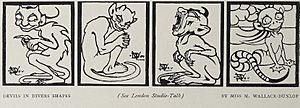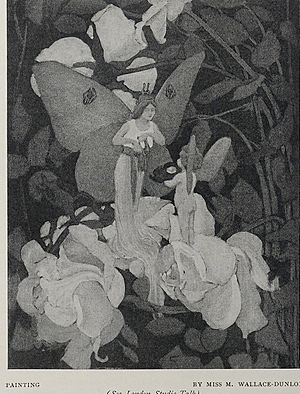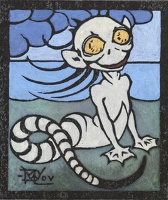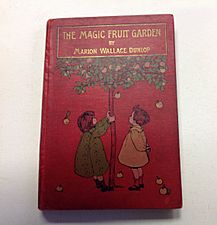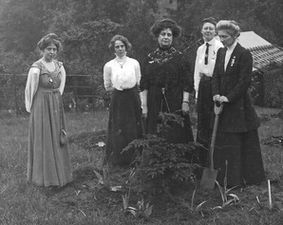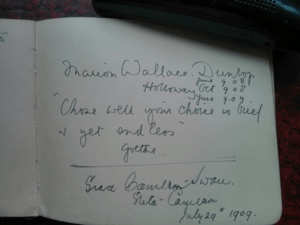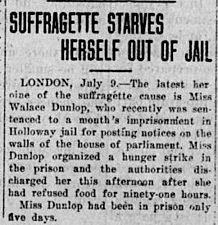Marion Wallace Dunlop facts for kids
Quick facts for kids
Marion Wallace Dunlop
|
|
|---|---|
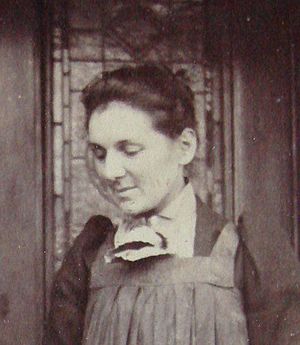 |
|
| Born | 22 December 1864 Leys Castle, Inverness, Scotland
|
| Died | 12 September 1942 (aged 77) Guildford, Surrey, England
|
| Nationality | Scottish |
| Occupation | Artist and writer |
| Known for | Devising hunger strike as a means of suffragette protest |
Marion Wallace Dunlop (born 22 December 1864 – died 12 September 1942) was a Scottish artist and writer. She is famous for being the first British suffragette to go on a hunger strike. This happened on 5 July 1909, after she was arrested for protesting.
A suffragette was a woman who fought for the right to vote. Marion Wallace Dunlop refused to eat unless she was treated like a political prisoner, not a common criminal. Her protest method inspired many other suffragettes. It also influenced leaders like M. K. Gandhi and James Connolly. They later used fasting to protest against British rule. Marion Wallace Dunlop was a key member of the Women's Social and Political Union. She helped design their marches and banners.
Contents
Marion Wallace Dunlop: A Champion for Women's Rights
Early Life and Art
Marion Wallace Dunlop was born at Leys Castle, Inverness, Scotland. Her birthday was 22 December 1864. Her parents were Robert Henry Wallace Dunlop and Lucy Wallace Dunlop.
Many people thought she studied at the Slade School of Fine Art in London. However, there are no official records of her attending that school. Her paintings were shown at the Royal Academy in 1903, 1905, and 1906. She also illustrated children's books. In 1899, she created pictures for Fairies, Elves, and Flower Babies and The Magic Fruit Garden. Her art style was called art-nouveau.
Marion Wallace Dunlop was a vegetarian. This means she did not eat meat. She also joined the Theosophical Society in 1911, but left in 1913.
Fighting for the Vote
Marion Wallace Dunlop became a very active member of the Women's Social and Political Union (WSPU). This group worked hard to get women the right to vote.
She was first arrested in 1908 for "obstruction" near the House of Commons. This means she was blocking the way during a protest. She was arrested again in 1908 for leading a women's march.
In 1909, she was arrested a third time. This was because she stenciled a message on a wall of the House of Commons. The message was from the Bill of Rights. It said, "It is the right of the subject to petition the King, and all commitments and prosecutions for such petitioning are illegal." This means people have the right to ask the King for things, and they should not be arrested for it.
Her Famous Hunger Strike
Marion Wallace Dunlop was arrested for stenciling the message on 2 July 1909. After her arrest, she started her first hunger strike. It was her own idea to stop eating. No one told her to do it.
Why She Went on Strike
She wanted to be treated as a political prisoner. This meant she believed her actions were for a political cause, not just a crime. She felt she should have different rights in prison.
Soon after she started, hunger strikes became a common way for suffragettes to protest. Christabel Pankhurst, another suffragette leader, said that Marion Wallace Dunlop acted alone. She told the Home Secretary that she would not eat until she was treated as a political prisoner.
The Impact of Her Protest
Marion Wallace Dunlop fasted for 91 hours. This is about four days. She was then released on 8 July 1909 because she was becoming very ill.
Her hunger strike was a big success. It showed the WSPU a new powerful way to protest. Because of this, the British Government started force-feeding prisoners in September 1909. This meant they would make prisoners eat against their will. Marion Wallace Dunlop and other suffragettes who went on hunger strikes received a special Hunger Strike Medal from the WSPU.
Later Life and Legacy
When Emmeline Pankhurst, a very important suffragette leader, died in 1928, Marion Wallace Dunlop was one of the people who carried her coffin. After Emmeline's death, Marion took care of Mary, who was Emmeline's adopted daughter.
Marion Wallace Dunlop passed away on 12 September 1942. She died at Mount Alvernia Nursing Home in Guildford.
Gallery
-
Annie Kenney, Kitty Kenney, Florence Haig, Mary Blathwayt and Marion Wallace-Dunlop at "Suffragette's Rest"
See also
 In Spanish: Marion Wallace Dunlop para niños
In Spanish: Marion Wallace Dunlop para niños


